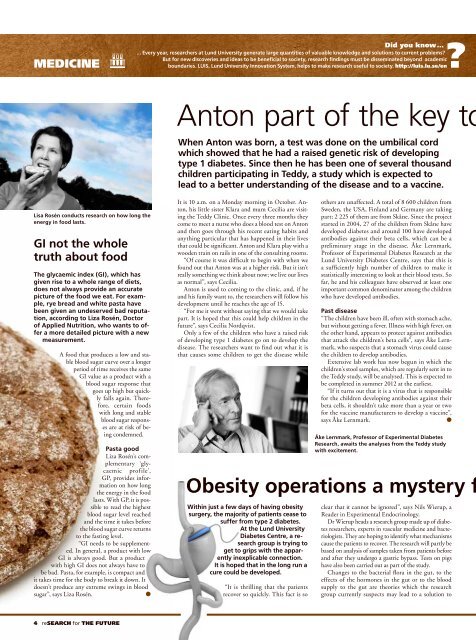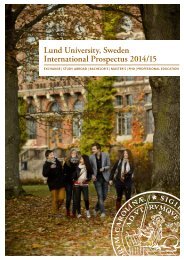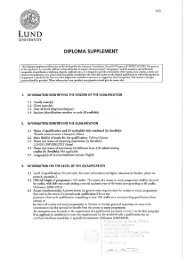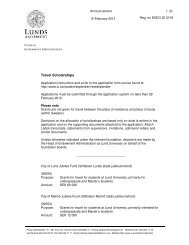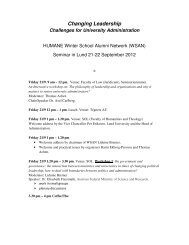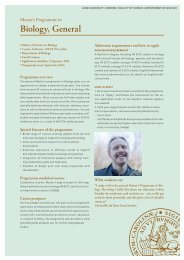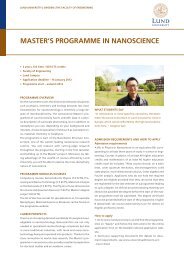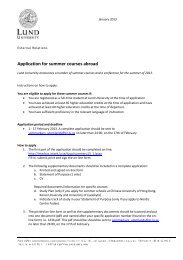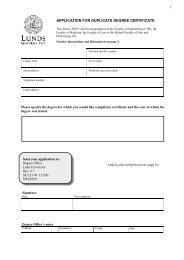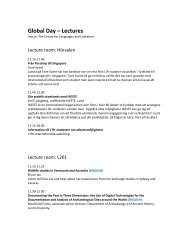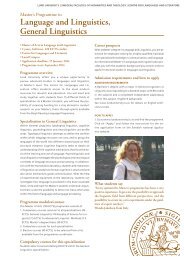"ReSearch for the Future" magazine (Pdf, 10 Mb) - Lund University
"ReSearch for the Future" magazine (Pdf, 10 Mb) - Lund University
"ReSearch for the Future" magazine (Pdf, 10 Mb) - Lund University
- No tags were found...
You also want an ePaper? Increase the reach of your titles
YUMPU automatically turns print PDFs into web optimized ePapers that Google loves.
medicineDid you know ...?... Every year, researchers at <strong>Lund</strong> <strong>University</strong> generate large quantities of valuable knowledge and solutions to current problems?But <strong>for</strong> new discoveries and ideas to be beneficial to society, research findings must be disseminated beyond academicboundaries. LUIS, <strong>Lund</strong> <strong>University</strong> Innovation System, helps to make research useful to society. http://luis.lu.se/enAnton part of <strong>the</strong> key toWhen Anton was born, a test was done on <strong>the</strong> umbilical cordwhich showed that he had a raised genetic risk of developingtype 1 diabetes. Since <strong>the</strong>n he has been one of several thousandchildren participating in Teddy, a study which is expected tolead to a better understanding of <strong>the</strong> disease and to a vaccine.Lisa Rosén conducts research on how long <strong>the</strong>energy in food lasts.GI not <strong>the</strong> wholetruth about foodThe glycaemic index (GI), which hasgiven rise to a whole range of diets,does not always provide an accuratepicture of <strong>the</strong> food we eat. For example,rye bread and white pasta havebeen given an undeserved bad reputation,according to Liza Rosén, Doctorof Applied Nutrition, who wants to offera more detailed picture with a newmeasurement.A food that produces a low and stableblood sugar curve over a longerperiod of time receives <strong>the</strong> sameGI value as a product with ablood sugar response thatgoes up high but quicklyfalls again. There<strong>for</strong>e,certain foodswith long and stableblood sugar responsesare at risk of beingcondemned.Pasta goodLiza Rosén’s complementary‘glycaemicprofile’,GP, provides in<strong>for</strong>mationon how long<strong>the</strong> energy in <strong>the</strong> foodlasts. With GP, it is possibleto read <strong>the</strong> highestblood sugar level reachedand <strong>the</strong> time it takes be<strong>for</strong>e<strong>the</strong> blood sugar curve returnsto <strong>the</strong> fasting level.“GI needs to be supplemented.In general, a product with lowGI is always good. But a productwith high GI does not always have tobe bad. Pasta, <strong>for</strong> example, is compact andit takes time <strong>for</strong> <strong>the</strong> body to break it down. Itdoesn’t produce any extreme swings in bloodsugar”, says Liza Rosén. ●It is <strong>10</strong> a.m. on a Monday morning in October. Anton,his little sister Klara and mum Cecilia are visiting<strong>the</strong> Teddy Clinic. Once every three months <strong>the</strong>ycome to meet a nurse who does a blood test on Antonand <strong>the</strong>n goes through his recent eating habits andanything particular that has happened in <strong>the</strong>ir livesthat could be significant. Anton and Klara play with awooden train on rails in one of <strong>the</strong> consulting rooms.“Of course it was difficult to begin with when wefound out that Anton was at a higher risk. But it isn’treally something we think about now; we live our livesas normal”, says Cecilia.Anton is used to coming to <strong>the</strong> clinic, and, if heand his family want to, <strong>the</strong> researchers will follow hisdevelopment until he reaches <strong>the</strong> age of 15.“For me it went without saying that we would takepart. It is hoped that this could help children in <strong>the</strong>future”, says Cecilia Nordqvist.Only a few of <strong>the</strong> children who have a raised riskof developing type 1 diabetes go on to develop <strong>the</strong>disease. The researchers want to find out what it isthat causes some children to get <strong>the</strong> disease whileWithin just a few days of having obesitysurgery, <strong>the</strong> majority of patients cease tosuffer from type 2 diabetes.At <strong>the</strong> <strong>Lund</strong> <strong>University</strong>Diabetes Centre, a researchgroup is trying toget to grips with <strong>the</strong> apparentlyinexplicable connection.It is hoped that in <strong>the</strong> long run acure could be developed.“It is thrilling that <strong>the</strong> patientsrecover so quickly. This fact is soo<strong>the</strong>rs are unaffected. A total of 8 600 children fromSweden, <strong>the</strong> USA, Finland and Germany are takingpart; 2 225 of <strong>the</strong>m are from Skåne. Since <strong>the</strong> projectstarted in 2004, 27 of <strong>the</strong> children from Skåne havedeveloped diabetes and around <strong>10</strong>0 have developedantibodies against <strong>the</strong>ir beta cells, which can be apreliminary stage in <strong>the</strong> disease. Åke Lernmark,Professor of Experimental Diabetes Research at <strong>the</strong><strong>Lund</strong> <strong>University</strong> Diabetes Centre, says that this isa sufficiently high number of children to make itstatistically interesting to look at <strong>the</strong>ir blood tests. Sofar, he and his colleagues have observed at least oneimportant common denominator among <strong>the</strong> childrenwho have developed antibodies.Past disease“The children have been ill, often with stomach ache,but without getting a fever. Illness with high fever, on<strong>the</strong> o<strong>the</strong>r hand, appears to protect against antibodiesthat attack <strong>the</strong> children’s beta cells”, says Åke Lernmark,who suspects that a stomach virus could cause<strong>the</strong> children to develop antibodies.Extensive lab work has now begun in which <strong>the</strong>children’s stool samples, which are regularly sent in to<strong>the</strong> Teddy study, will be analysed. This is expected tobe completed in summer 2012 at <strong>the</strong> earliest.“If it turns out that it is a virus that is responsible<strong>for</strong> <strong>the</strong> children developing antibodies against <strong>the</strong>irbeta cells, it shouldn’t take more than a year or two<strong>for</strong> <strong>the</strong> vaccine manufacturers to develop a vaccine”,says Åke Lernmark.●Åke Lernmark, Professor of Experimental DiabetesResearch, awaits <strong>the</strong> analyses from <strong>the</strong> Teddy studywith excitement.Obesity operations a mystery fclear that it cannot be ignored”, says Nils Wierup, aReader in Experimental Endocrinology.Dr Wierup heads a research group made up of diabetesresearchers, experts in vascular medicine and bacteriologists.They are hoping to identify what mechanismscause <strong>the</strong> patients to recover. The research will partly bebased on analysis of samples taken from patients be<strong>for</strong>eand after <strong>the</strong>y undergo a gastric bypass. Tests on pigshave also been carried out as part of <strong>the</strong> study.Changes to <strong>the</strong> bacterial flora in <strong>the</strong> gut, to <strong>the</strong>effects of <strong>the</strong> hormones in <strong>the</strong> gut or to <strong>the</strong> bloodsupply to <strong>the</strong> gut are <strong>the</strong>ories which <strong>the</strong> researchgroup currently suspects may lead to a solution to4 reSEARCH <strong>for</strong> THE FUTURE


